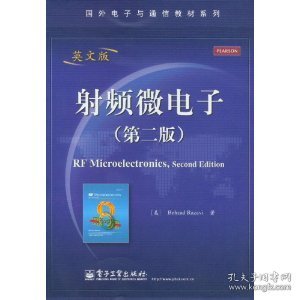-
作者:
拉扎维(Behzad Razavi)
-
出版社:
电子工业出版社
-
ISBN:
9787121176036
-
出版时间:
2012-08
-
版次:
1
-
装帧:
平装
-
开本:
16开
-
纸张:
胶版纸
-
页数:
916页
-
字数:
99999千字
-
作者:
拉扎维(Behzad Razavi)
-
出版社:
电子工业出版社
-
ISBN:
9787121176036
-
出版时间:
2012-08
-
纸张:
胶版纸
-
页数:
916页
-
字数:
99999千字
售价
¥
317.00
定价
¥128.00
品相
九五品
上书时间2024-04-07
卖家超过10天未登录
手机购买
![]()
微信扫码访问
-
-
商品描述:
-
基本信息
书名:英文版 射频微电子 第2版
定价:128元
作者:拉扎维(Behzad Razavi)
出版社:电子工业出版社
出版日期:2012-08-01
ISBN:9787121176036
字数:1947000
页码:916
版次:1
装帧:平装
开本:16开
商品重量:
编辑推荐
《国外电子与通信教材系列:射频微电子(第2版)(英文版)》既可作为高年级本科生或硕士研究生的双语教学教材,又可满足集成电路设计工作者进一步提高自身知识和设计技能的需求。《国外电子与通信教材系列:射频微电子(第2版)(英文版)》是广受好评的射频微电子畅销书,针对的架构、电路和器件进行了全面扩展与更新。
内容提要
本书侧重系统级描述,综合了无线通信电路系统描述、器件特性及单元电路分析,讨论架构、电路和器件。和第2章首先介绍射频电子学基本概念和术语;第3章和第4章讨论通信系统层的建模、检测、多路存取等技术及无线标准;第5章讨论无线前端收发器的结构和集成电路的实现,第6章到第9章详细讨论了低噪声放大器和混频器、振荡器、频率综合器和功放器电路原理和分析方法。
目录
CHAPTER 1 INTRODUCTION TO RF AND WIRELESS TECHNOLOGY 1.1 A Wireless World 1.2 RF Design Is Challenging 1.3 The Big Picture References CHAPTER 2 BASIC CONCEPTS IN RF DESIGN 2.1 General Considerations 2.1.1 Units in RF Design 2.1.2 Time Variance 2.1.3 Nonlinearity 2.2 Effects of Nonlinearity 2.2.1 Harmonic Distorlion 2.2.2 Gain Compression 2.2.3 Cross Modulation 2.2.4 Intermodulation 2.2.5 Cascaded Nonlinear Stages 2.2.6 AM/PM Conversion 2.3 Noise 2.3.1 Noise as a Random Process 2.3.2 Noise Spectrum 2.3.3 Effect of Transfer Function on Noise 2.3.4 Device Noise 2.3.5 Representation of Noise in Circuits 2.4 Sensitivity and Dynamic Range 2.4.1 Sensitivity 2.4.2 Dynamic Range 2.5 Passive Impedance Transformation 2.5.1 Quality Factor 2.5.2 Series-to-Parallel Conversion 2.5.3 Basic Matching Networks 2.5.4 Loss in Matching Networks 2.6 Scattering Parameters 2.7 Analysis of Nonlinear Dynamic Systems 2.7.1 Basic Considerations 2.8 Volterra Series 2.8.1 Method of Noniinear Currents References Problems CHAPTER 3 COMMUNICATION CONCEPTS 3.1 General Considerations 3.2 Analog Modulation 3.2.1 Amplitude Modulation 3.2.2 Phase and Frequency Modulation 3.3 Digital Modulation 3.3.1 Intersymbol Interference 3.3.2 Signal Constellations 3.3.3 Quadrature Modulation 3.3.4 GMSK and GFSK Modulation 3.3.5 Quadrature Amplitude Modulation 3.3.6 Orthogonal Frequency Division Multipleng 3.4 Spectral Regrowth 3.5 Mobile RF Communications 3.6 Multiple Access Techniques 3.6.1 Time and Frequency Division Dupleng 3.6.2 Frequency-Division Multiple Access 3.6.3 Time-Division Multiple Access 3.6.4 Code-Division Multiple Access 3.7 Wireless Standards 3.7.1 GSM 3.7.2 IS-95 CDMA 3.7.3 Wideband CDMA 3.7.4 Bluetooth 3.7.5 IEEE802.11a/b/g 3.8 Appendix Ⅰ: Differential Phase Shift Keying References Problems CHAPTER 4 TRANSCEIVER ARCHITECTURES 4.1 General Considerations 4.2 Receiver Architectures 4.2.1 Basic Heterodyne Receivers 4.2.2 Modern Heterodyne Receivers 4.2.3 Direct-Conversion Receivers 4.2.4 Image-Reject Receivers 4.2.5 Low-IF Receivers 4.3 Transmitter Architectures 4.3.1 General Considerations 4.3.2 Direct-Conversion Transmitters 4.3.3 Modern Direct-Conversion Transmitters 4.3.4 Heterodyne Transmitters 4.3.5 Other TX Architectures 4.4 OOK Transceivers References Problems CHAPTER 5 LOW-NOISE AMPLIFIERS 5.1 General Considerations 5.2 Problem of Input Matching 5.3 LNA Topologies 5.3.1 Common-Source Stage with Inductive Load 5.3.2 Common-Source Stage with Resistive Feedback 5.3.3 Common-Gate Stage 5.3.4 Cascode CS Stage with Inductive Degeneration 5.3.5 Variants of Common-Gate LNA 5.3.6 Noise-Cancelling LNAs 5.3.7 Reactance-Cancelling LNAs 5.4 Gain Switching 5.5 Band Switching 5.6 High-IP2 LNAs 5.6.1 Differential LNAs 5.6.2 Other Methods of IP2 Improvement 5.7 Nonlinearity Calculations 5.7.1 Degenerated CS Stage 5.7.2 Undegenerated CS Stage 5.7.3 Differential and Quasi-Differential Pairs 5.7.4 Degenerated Differential Pair References Problems CHAPTER 6 MIXERS 6.1 General Considerations 6.1.1 Performance Parameters 6.1.2 Mixer Noise Figures 6.1.3 Single-Balanced and Double-Balanced Mixers 6.2 Passive Downconversion Mixers 6.2.1 Gain 6.2.2 LO Self-Ming 6.2.3 Noise 6.2.4 Input Impedance 6.2.5 Current-Driven Passive Mixers 6.3 Active Downconversion Mixers 6.3.1 Conversion Gain 6.3.2 Noise in Active Mixers 6.3.3 Linearity 6.4 Improved Mixer Topologies 6.4.1 Active Mixers with Current-Source Helpers 6.4.2 Active Mixers with Enhanced Transconductance 6.4.3 Active Mixers with High IP2 6.4.4 Active Mixers with Low Flicker Noise 6.5 Upconversion Mixers 6.5.1 Performance Requirements 6.5.2 Upconversion Mixer Topologies References Problems CHAPTER 7 PASSIVE DEVICES 7.1 GeneraIConsiderations 7.2 Inductors 7.2.1 Basic Structure 7.2.2 Inductor Geometries 7.2.3 Inductance Equations 7.2.4 Parasitic Capacitances 7.2.5 Loss Mechanisms 7.2.6 Inductor Modeling 7.2.7 Alternative Inductor Structures 7.3 Transformers 7.3.1 Transformer Structures 7.3.2 Effect of Coupling Capacitance 7.3.3 Transformer Modeling 7.4 Transmission Lines 7.4.1 T-Line Structures 7.5 Varactors 7.6 Constant Capacitors 7.6.1 MOS Capacitors 7.6.2 Metal-Plate Capacitors References Problems CHAPTER 8 OSCILLATORS 8.1 Performance Parameters 8.2 Basic Principles 8.2.1 Feedback View of Oscillators 8.2.2 One-Port View of Oscillators 8.3 Cross-Coupled Oscillator 8.4 Three-Point Oscillators 8.5 Voltage-Controlled Oscillators 8.5.1 Tuning Range Limitations 8.5.2 Effect of Varactor Q 8.6 LC VCOs with Wide Tuning Range 8.6.1 VCOs with Continuous Tuning 8.6.2 Amplitude Variation with Frequency Tuning 8.6.3 Discrete Tuning 8.7 Phase Noise 8.7.1 Basic Concepts 8.7.2 Effect of Phase Noise 8.7.3 Analysis of Phase Noise: Approach Ⅰ 8.7.4 Analysis of Phase Noise: Approach Ⅱ 8.7.5 Noise of Bias Current Source 8.7.6 Figures of Merit of VCOs 8.8 Design Procedure 8.8.1 Low-Noise VCOs 8.910 Interface 8.10 Mathematical Model of VCOs 8.11 Quadrature Oscillators 8.11.1 Basic Concepts 8.11.2 Properties of Coupled Oscillators 8.11.3 Improved Quadrature Oscillators 8.12 Appendix Ⅰ: Simulation of Quadrature Oscillators References Problems …… CHAPTER 9 PHASE-LOCKED LOOPS CHAPTER 10 INTEGER-N FREQUENCY SYNTHESIZERS CHAPTER 11 FRACTIONAL-N SYNTHESIZERS CHAPTER 12 POWER AMPLIFIERS CHAPTER 13 TRANSCEIVER DESIGN EXAMPLE INDEX
作者介绍
作者:(美国)拉扎维(Behzad Razavi)
序言

![]()
孔网啦啦啦啦啦纺织女工火锅店第三课
开播时间:09月02日 10:30
即将开播,去预约


直播中,去观看

 占位居中
占位居中




 直播中,去观看
直播中,去观看